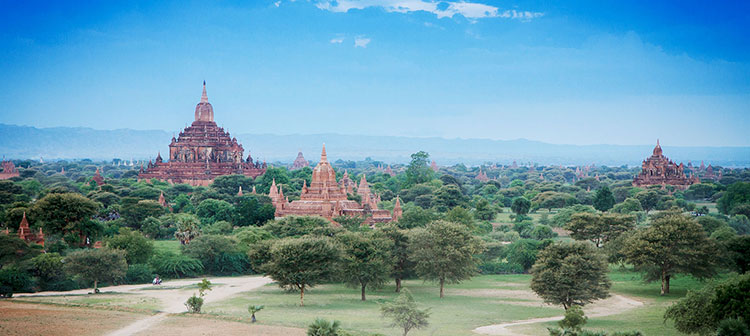
Known as the city of four million pagodas, is one of the richest archaeological sites in Asia and the main tourist destination in Myanmar. It was also capital of the First Myanmar Empire. This enchanting city is situated on the eastern bank of the Ayeyarwaddy River, about 193 km south of Mandalay. The ruins of Bagan City cover an area of 42 sq. km containing over 2000 edifices. The majority of these well-preserved temples and pagodas offer a rich architectural heritage from the 11th to 13th century era.
How to get there:
It takes about one hour and twenty minutes to fly from Yangon to Bagan. There are daily flights to Bagan from Yangon, Mandalay and Heho. By overland, it takes 14 hours from Yangon and 7 hours from Mandalay by coach. There is a regular train between Bagan and Mandalay too. The newly constructed railway between Mandalay and Bagan was unveiled in September, 1996. Express trains from Yangon to Mandalay stop at Thazi, from where it is accessible to Bagan by a 3-hour drive. There is also a double-decker steamer service between Mandalay and Bagan and the cruises " the Road to Mandalay" operated by E & O Express, RV Pandaw 1947 operated by Ayravata Cruises, and Irrawaddy Princess.
What to see
Tharabar Gate:
The gateway was built during the 9th century, by King Pyin Pyar Min (A.D 84a6 -878). He built the fortress of Bagan with 12 gateways. The Tharaba Gateway was located on the east side of the palace. It was used as the main gate to the city. "Tharaba" meaning "The Gate which can prevent the arrows of the enemy". The gate is guarded by Min Maha Giri (the brother) and Namadaw (the sister) spirits on each side of the gate.
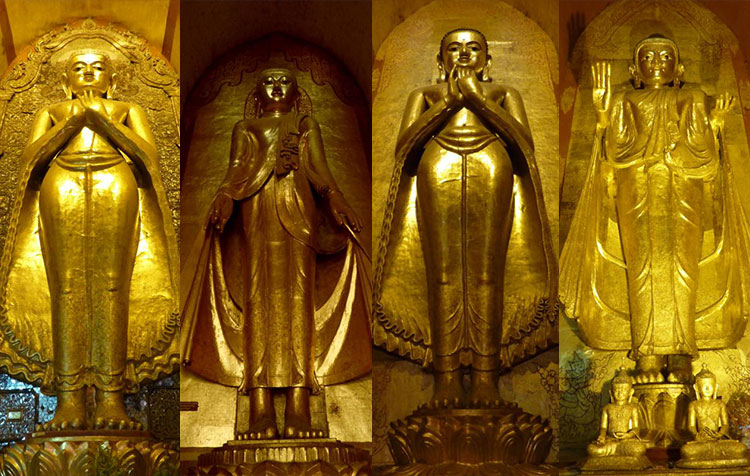
Ananda Temple:
Completed in 1090, Ananda Temple is King Kyansittha's masterpiece and crowning achievement of the early style temple architecture. The structural layout plan is that of a perfect Greek cross with four huge Buddha images in standing position, facing in four different directions, and a series of eighty relieves depicting the early stages of the Buddha's life from the Birth to His Enlightenment.
Ananda Okkyaung Monastery:
Is a small red Brick Monastery situated within the temple compound of Ananda Temple. The inside walls are covered in 18th century paintings depicting Buddha's life and elements of the history of Bagan.
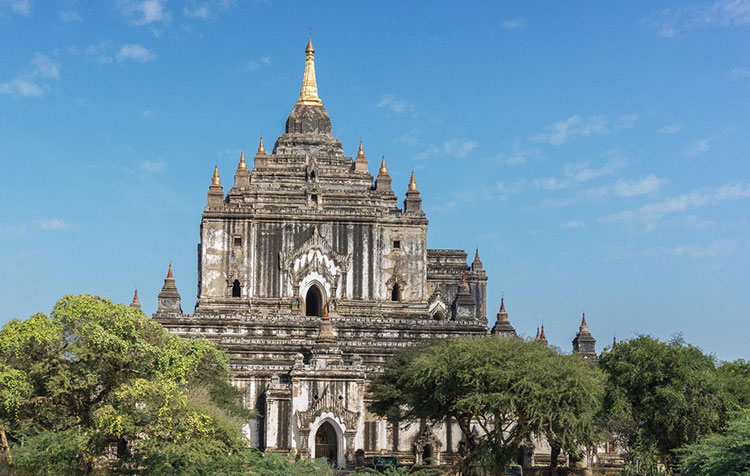
Thatbyinnyu Temple:
Over 66 meters high, and built by King Alaungsithu in the middle of the 12th century, this white stucco building overtops all other monuments as the highest pagoda on the Bagan plain.
Nathlaung Kyaung:
Located slightly to the west of Thatbyinnyu and inside the old city walls, is the only remaining Hindu temple in Bagan. It was believed to be built during (A.D 931-964). In the early days of Bagan, people used to believe in Hinduism, and worshipped Vishu, Brahman and many other Hindu gods. This used to be a place to worship those gods. But afterwards, King Anawrahta brought Theravada Buddhism to Bagan with the conquest of Thaton, and made the Hinduism vanish. It clearly is one of the earliest of the Bagan temples.
Ngakywenadaung Paya:
Is a medium size early Pyu type brick masonry stupa. Its date of construction remains uncertain. On the external walls and each face had been carved in brick the ten misadventures of Vishnu. These statues were placed upright in niches decorated with the pilasters. The murals are contemporary sculptures. The center of the temple is occupied by an enormous brick mass surrounded classically bricks. It is this mass which supports the dome and will sikhara it. The name even of the temple is curious, it means: "the temple where the spirits are confined" and perhaps announces a relation with the nats, which had taken refuge here, not being able to do it in a traditional Buddhist temple.
Shwegugyi Temple:
Standing on the high brick plinth, this temple was built by King Alaungsithu in 1131 AD. The arch pediments, pilasters, plinth and cornice molding are decorated with fine stucco carvings, evident of Myanmar architecture of the early 12th Century.
Gawdawpalin Temple:
This temple was built by King Narapatisithu during the 12th century. It is about 60 meters high with a fine view over the ruins of the Bagan plains and the mighty Ayeyarwaddy River.
Myoe Daung Monastery:
It's the oldest and the finest monastery of that age. The complex contains two monasteries, numerous pyathats, pavilions, rest houses and ancillary buildings. Located in the north of Old Bagan.
The Nat Taung complex actually contains two monasteries, numerous pyathats, pavilions, rest houses and ancillary buildings. The main monastery building, with an east-west orientation, is approximately 130 ft. x 115 ft. (40 m. x 35 m. Its glory and what should be a major claim to prominence lies in its numerous woodcarvings which are also mostly from the late Kon-baung period of the mid- to late 19th century.
Archaeological Museum:
The museum run by Archaeological Department is situated near the Gawdawpalin Temple. It has a collection of more than 2,000 items including Buddha statues, stucco pieces, terra-cotta cups and pots. Open daily except Monday and public holidays.
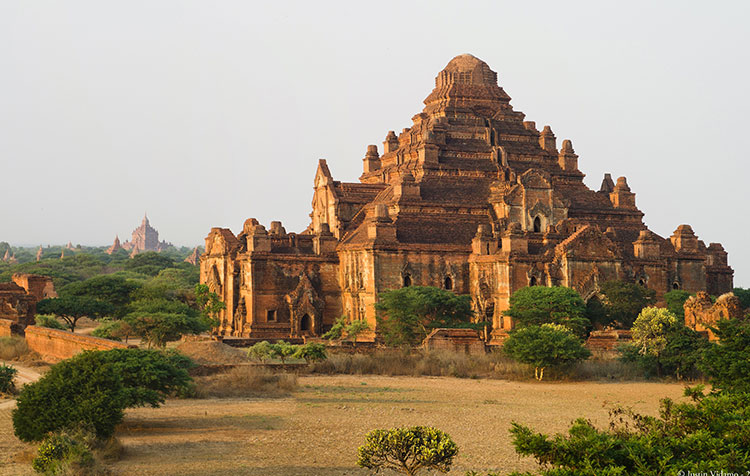
Dhammayangyi Temple:
Built by King Narathu during A.D 1165 is Bagan's most massive shrine. Among the four extraordinary temples in Bagan, Dhammayangyi is well known for the mass and thickness of the temple
Bupaya Pagoda:
Standing on the brink of the Ayeyarwaddy River, the Bupaya Pagoda is a conspicuous landmark for travelers along the river. This pagoda with bulbous dome resembling the ''Bu'' or gourd is a favorite spot for visitors to watch the sunset.
Sulamani Temple:
Is one of Bagan's premier temple attractions. The name itself means Crowning Jewel or Small Ruby. It was the first and most important temple of the late period (1170-1300) of Bagan monument building. It was one of many temples and stupas built by Narapatisithu. This temple is similar to Htilominlo and the Gawdawpalin in architecture but with better interior lighting. It stands beyond the Dhammayangyi Temple. Important features of the Sulamani include its fine brickwork and use of stone in both load-bearing areas as well as on vulnerable external corner elements. The interior was once painted with fine frescoes but only dim traces can be seen today.
Pyayhatgyi:
This monastery of Indian influence is situated southeast of the Sulamani. This monastery of Indian influence probably had around the timber structures, even a hall of ordination, even a small palate.
Pyathatgyi is really the most interesting monastery if one is interested in the last pagoda of Bagan, and with the techniques of construction. It was perhaps the last great construction of the dynasty of Bagan. The technique of the vaults on corridors intersected from/to each other is completely exceptional.
Mingalazedi Pagoda:
The last pagoda of the Bagan dynasty built by King Narathihapatae (1256-1287). Started building in 1268, and before it was finished, a prophecy arose that "once the pagoda is finished, the Kingdom would be destroyed". The King thus stopped the works for 6 years. He resumed works in 1274. Ten years later, he had to run away from Bagan to escape the invading Mongols.
Shwesandaw Pagoda:
King Anawrahta built this graceful circular pagoda in 1057. The five terraces once had terra-cotta plaques showing scenes from the Jataka. The pagoda bell rises from two octagonal bases, which top the five square terraces. The upper terrace of Shwesandaw Pagoda has become a popular sunset-viewing spot. Try the place for sunrise.
Shinbinthalyaung:
Is a long low, rectangular brick structure, a little to the west of the Shwesandaw Pagoda. The temple itself is not very distinguished, but it houses the Shinbinthalaung Buddha image made during the 11th Century. The temple in which the Buddha image lies is about 84 feet in length, and the image itself is 70 feet in length. The Buddha is in the position of Parinibbana, the Decease, lying on his right side, his cheek resting on his right hand.
Lawkahteikpan Temple:
Close to the Shwesandaw stands the Lawkahteikpan Temple - small but interesting for its excellent frescoes and inscriptions in both Myanmar and Mon.
Gubyaukgyi Temple (Wetkyi-In):
It is a 13th century temple with a spire resembling the Mahabodhi Temple at Bodh Gaya in India. This temple is known for its wall paintings depicting scenes from the Jatakas (life stories of the Buddha).
Nyaung Oo & Wetkyi-in:
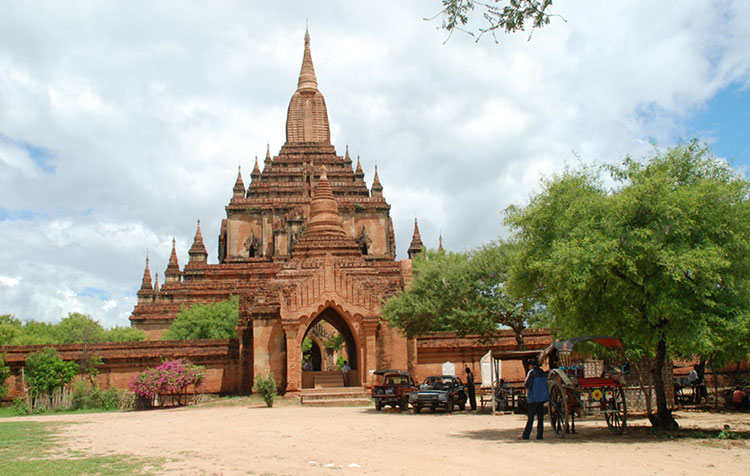
Htilominlo Temple:
Built in 1211 AD by King Nadaungmya, the Htilominlo is one of the largest temples of Bagan. It is a double-storied structure rising 50 meters in height. This temple is noted for its fine plaster carvings on the arch pediments, frieze and pilaster.
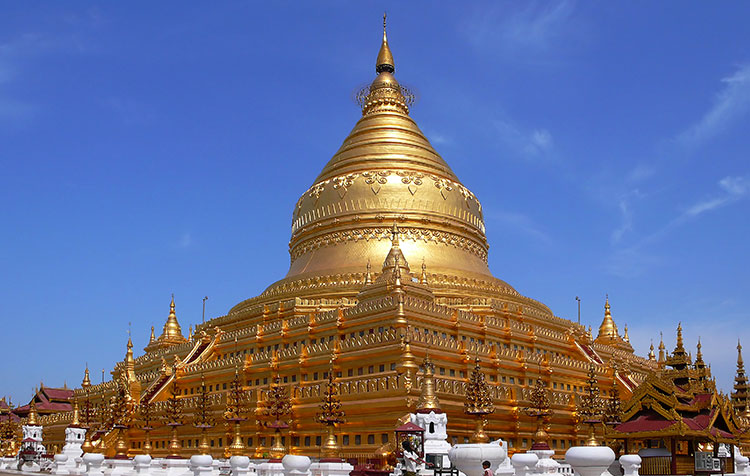
Shwezigon Pagoda:
It was first built by King Anawrahta, the founder of the First Myanmar Empire, and completed by King Kyansittha in 1084. Shwezigon Pagoda is the prototype for succeeding generations of pagodas in Myanmar. There are green glazed plaques depicting scenes from the Jatakas. The pagoda festival is held from late October till early November.
MyinKaba:
Nanpaya and Manuha Temple:
Built by Mon King Manuha of Thaton, who was a prisoner of war by King Anawrahta. Some say King Manuha used Nanpaya as his residence during his years of exile in Bagan. The quality of masonry in both of these temples is very fine. The finest feature of the whole temple is the stone relief carvings of the Hindu deity Bhrama in Nanpaya.
Gubyaukgyi Temple (Myinkaba):
Was built during the A.D 1113, by Raza Kumar, the son of King Kyansitthar and Queen Thanbula. The Gubyaukgyi Temple is a fine temple in the Early Style, square, with a vestibule in the east. The Gubyaukgyi is also noted for the paintings, which cover the walls of the vestibule, the corridor and the sanctum. These paintings are among the earliest now extant in Bagan.
Nagayon Temple:
A portico in the north, paved with green glazed stones and having niches holding stone reliefs of the Buddha, provides access to the Nagayon. Within the temple itself, the central shrine contains a huge standing image of the Buddha. Two smaller images flank the main one. A corridor, also paved with green glazed stones, runs around the central shrine. Dim light comes in through the perforated windows of the outer walls. The walls of the corridor have niches holding stone sculptures depicting the Buddhas previous to Gotama, as well as paintings showing scenes from the Jatakas and the Final Life of Gotama Buddha.
Abeyadana Temple:
This Pagoda built by King Kyanzittha in adoration for his wife contains a seated brick Buddha that has now been mostly covered concrete. However the true attraction lies in the stunning paintings that cover the inner walls, most representing images from Mahayana Buddhism, such as Brahma, Indra and Vishnu.
New Bagan:
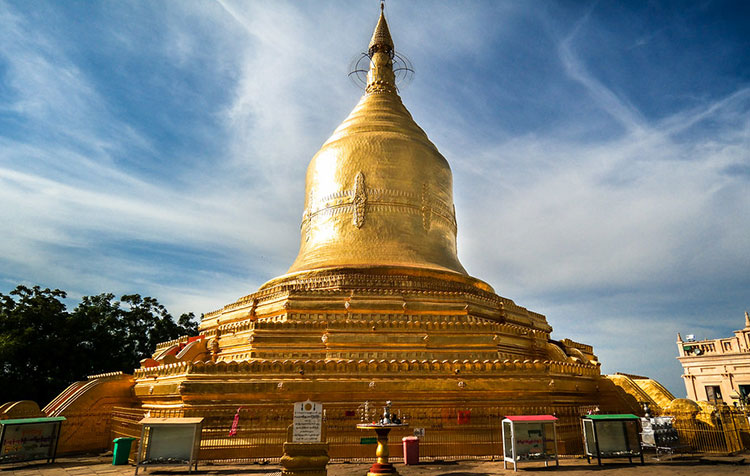
Lawkananda Pagoda:
Situated at the edge of the river, this large gilded Stupa is one of the prominent visual landmarks of Bagan and can be seen by all boats that pass along the Ayeyarwady River.
Ashe Petleik and Anauk Petleik Pagodas:
The two Petleik pagodas (the Ashe (Eastern) and Anauk (Western) - belong to the 11th century and have been assigned to the reign of Anawrahta (1044-1077). The Western pagoda is better preserved and has a bell-shaped dome, with rings of moulding at the middle and towards the base. An unusual feature of the dome is the four deep niches at the cardinal points to house images of the Buddha. A damaged bowl-shaped disc rests on the dome in the Western Pagoda, while in the Eastern Pagoda a box-like relic chamber occupies the corresponding position. The finial, which rises above, is in the form of a truncated cone.
Lacquer ware:
Masterpieces of lacquer ware have been the pride of Bagan since the days of the Bagan Empire. It is still the main industry of Bagan today and you can observe the making process of lacquer ware from the beginning to the finished products ready for sale at the shops. Lacquer ware like bowls, boxes, trays and paintings are the best souvenirs of Bagan.
Minnanthu Village:
Leimyethna Temple:
Resting on a platform, the temple is square in plan, with porches projecting on all four sides, and with the main entrance in the east. The superstructure consists of receding terraces, with crenellated parapets and small stupas at the corners, surmounted by a curvilinear spire, which is crowned by a stupa.
Phayathonzu Temple:
The name Phayathonzu Temple was given because the three pagodas of the same size, appearance and height existed on the same plinth. It is adorned with paintings of the 550 Jataka stories and ten other depictions plus small Thambuddhay figures. The frescoes and architecture are guessed to be of the late 13th century.
Pwasaw:
Dhammayazika Pagoda:
Dhammayazika Pagoda was built by King Narapati Sithu in 1198. At first glance looking much like the famous Shwezigon, the Dhammayazika is unusual because it has pentagonal terraces instead of the usual square ones. Above the three receding terraces, which are ornamented with glazed Jataka plaques raises a bell-shaped dome, which merges directly into a sharply tapering conical finial. On each of the five sides of the pagoda there is a small temple. The temples themselves are of the usual form, square in plan, with a porch for entrance, and surmounted by terraces and a curvilinear spire.

ENVIRONS:
Mount Popa:
Mount Popa, 1,500 meters high, rising out of the plain, is an extinct volcano located about 67km southeast of Bagan. It is generally known as the abode of legendary Nats or Spirit gods, for which the annual festival is held during the Myanmar month of Nayon (May-June).
Mt. Popa
Sale (Salei):
A town in Magwe Division in Central Myanmar, lying on the east bank of the Ayeyaerwaddy River is famous for three things; first it is the birthplace of a reputed Myanmar playwright named U Ponnya of the late Konbaung Period; secondly the plums of Salei which are seedless and of good quality and thirdly there is the largest Buddha Image of Lacquered wicker work in Myanmar. The 18-foot high image is now entirely gilt and its headband is adorned with glass mosaic, it bears the appearance of a solid metallic work though two or three persons can effortlessly lift it up. The Yoke Sone Monastery is closed every Monday & Tuesday.
Pakokku:
Pakokku is a typical upper Burmese market town. With the large and bustling market, a cigar factory and hand weaving workshop. You can make a tour by local bus which is a fun way of seeing the real life of this busy place and then travel outside the town to the little know archaeological site of Pakhangyi. We see the walls, visit the museum and a spectacular 19th century wood carved monastery.







